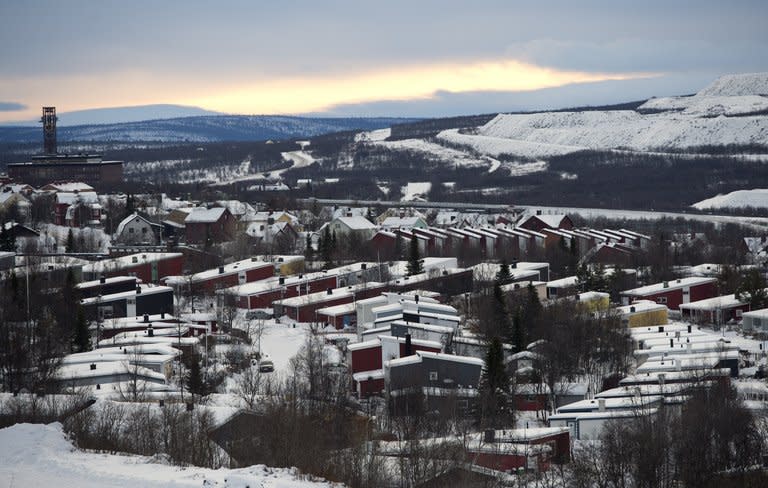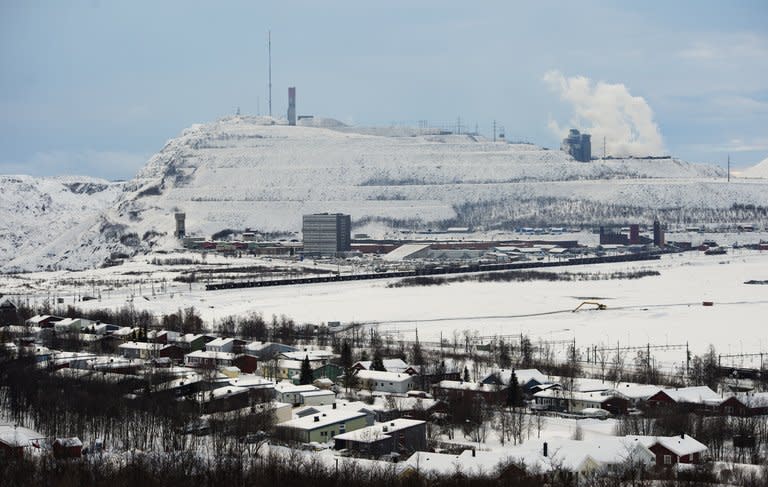To avoid collapse, Swedish town moves
Perched on a hill by the iron ore mine it was once built around, the sleepy northerly Swedish town of Kiruna is in the process of reinventing itself. It has to: in four years, it will have moved somewhere else. At the turn of the 19th century the area consisted of a handful of ramshackle buildings and traditional "lavoo", the dwellings of the indigenous Sami population that are similar to the teepee used by American Indians. But with large-scale mining came wealth and the town prospered, climbing further up the slope as new workers arrived and older neighbourhoods were abandoned when the mine began to encroach on them. The fortunes of the 23,000-strong town are still tied to what is now the largest iron ore mine in the world, extracting enough in a day to build more than six Eiffel Towers, together with neighbouring Malmberget. As LKAB's extraction moves deeper -- it's now at a depth of four kilometers (2.5 miles) -- and closer to the town, cracks have begun to appear underground. In 2004, state-controlled owner LKAB gave local politicians an ultimatum: move the parts of the city centre that could collapse if the company's underground expansion plans went ahead, or risk stifling Kiruna's largest employer. "There was an uproar when we found out," Ulrika Isaksson, a spokeswoman for the municipality, told AFP. "A press release went out saying that the whole town had to move." It turned out that only the buildings within a one-kilometre (half-mile) radius from the mine were affected, but that included most of the town centre. "It's only 35 percent of the town's total area," said deputy mayor Niklas Siren of the Left Party. Most buildings will simply be torn down, forcing their inhabitants to relocate, but some of those seen as being Kiruna landmarks will be dismantled and reassembled in their entirety at new locations. "The town centre will shift around three kilometres to the northeast," Isaksson said. "In four years, things could become very sentimental" since that is when the move will become visible, she said, referring to when the 1960s-era town hall and the houses around it will be torn down. After that it will be time for the train station and the main town square to relocate, and around 20 years from now the moving of Kiruna's church will mark the final phase of the project. The imposing red, wooden building whose exterior is designed to resemble a Sami "lavoo", has become the pride of Kiruna's inhabitants. It was a gift from LKAB in 1912, illustrating the company's central role in the town's history. "2,500 apartments will have to move," Isaksson said, not to mention hotels and commercial properties. For Siren, the move is not just about recreating Kiruna three kilometres (two miles) up the road, but also about reinventing the town. "We are going to build the best possible town centre, vibrant, sustainable and modern," he said. Although LKAB is paying for all the land it will use, the municipality is responsible for the urban planning of the new town. Next year it will choose an architect firm. No detailed timetable is available for the project at the moment. One thing is certain however: In 2018, the new town hall will have been completed and the old one will have given way to a park. Whereas the demolition of a single building can spark controversy in some towns, the inhabitants of Kiruna seem to be taking things in stride. People still pull their sleds through the snow-covered streets and there is nothing yet to suggest that in 2035 all of the buildings around them will be gone. "We know too little," said Anja Jakobsson, 51, without sounding bitter. "We are in favour of the transformation of the town. The development of the mine means that people in Kiruna will have jobs. But we're worried about our personal finances," she added. "People are afraid of not having the means (to relocate)," Martti Kivimaeki, an assistant deacon, said, but noted dryly that even though people were worried, they weren't turning to the Church. LKAB has pledged to buy the affected buildings for 125 percent of their value. "But that's not enough for a new-built house," Jakobsson said. The company will offer lower rents in the residential properties it owns for a limited period, but not indefinitely, said a spokeswoman, Ylva Sievertsson. "When you talk to people in Kiruna, you always hear: 'No, but we need the mine.' And with that, the discussion ends," argued Timo Vilgats, a municipal politician for the Green Party, the only one to question the need to move part of the town. He points to new iron extraction technologies that would not impact what happens above ground. Sievertsson denied his claims, saying that either the mine grows towards the town centre, or it shuts. LKAB employs some 2,100 people in Kiruna. Although the company's profit fell 27 percent in the third quarter to 2.48 billion kronor (287 million euros or $373 million), it plans to grow production volumes by 35 percent by 2015.





